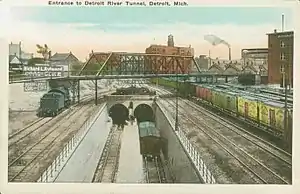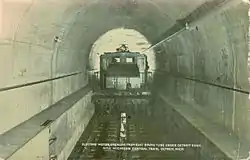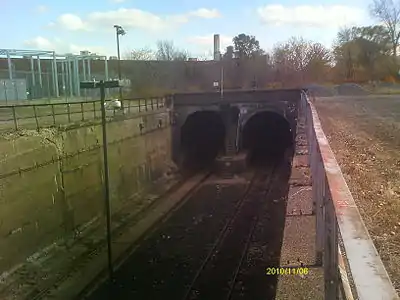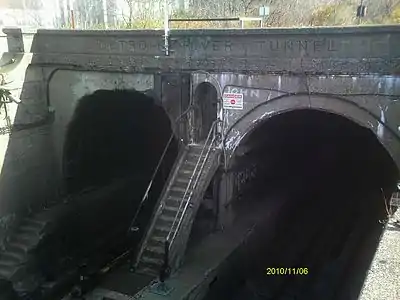Michigan Central Railway Tunnel
The Michigan Central Railway Tunnel is a railroad tunnel under the Detroit River connecting Detroit, Michigan, in the United States with Windsor, Ontario, in Canada. The U.S. entrance is south of Porter and Vermont streets near Rosa Parks Boulevard. The Canadian entrance is south of Wyandotte Street West between Cameron and Wellington Avenues. It was built by the Detroit River Tunnel Company for the Canada Southern Railway, leased by the Michigan Central Railroad and owned by the New York Central Railroad. The tunnel opened in 1910 and is still in use today by the Canadian Pacific Railway. On the Detroit side, the area around the tunnel is off limits to the general public and is routinely patrolled by officers and agents of the U.S. Department of Homeland Security, Canadian Pacific Police Service, CN Police, Detroit Police Department, and the security elements of the bridge company.
 Postcard picture, early 1900s | |
| Overview | |
|---|---|
| Location | Detroit River |
| Coordinates | 42.31849°N 83.06049°W |
| System | Canadian Pacific Railway |
| Start | Detroit, Michigan, US |
| End | Windsor, Ontario, Canada |
| Operation | |
| Work begun | October 1906 |
| Opened | July 26, 1910 |
| Owner | Canadian Pacific Railway |
| Operator | Detroit River Tunnel Company |
| Traffic | Freight |
| Technical | |
| Length | 1.6 mi (2.6 km) |
| No. of tracks | 2 |
| Track gauge | 1,435 mm (4 ft 8 1⁄2 in) standard gauge |
History


Prior to the construction of the tunnel, the Canada Southern Railway had several connections to Michigan at its west end, all train ferries. The northern one ran across the St. Clair River, connecting to the St. Clair and Western Railroad. The southern connection crossed the Detroit River south of Detroit, connecting to the Canada Southern Bridge Company at Grosse Ile. Additionally a branch (usually considered the main line) split from the line to Grosse Ile at Essex, running to the Detroit River at Windsor.
In 1891, the Grand Trunk Railway opened the St. Clair Tunnel at Port Huron, giving it an advantage over the Canada Southern and its car ferries. The Detroit River Tunnel Company was formed August 15, 1905, as a merger of the Michigan and Canada Bridge and Tunnel Company (in Michigan) and the Canada and Michigan Bridge and Tunnel Company (in Ontario). Construction began in October 1906 under the engineering supervision of The New York Central Railway's engineering vice president, William J. Wilgus. The Michigan Central Railway Tunnel opened for passenger service July 26, 1910. Freight service began September 15 and on October 16 all traffic began running via the tunnel, ending the use of a train car ferry. From opening it was operated by the Michigan Central Railroad under lease of December 19, 1906. It was the first immersed tube tunnel to carry traffic.
On the east (Canadian) side, the tunnel connected to the line that had served a train ferry at Windsor. On the west (U.S.) side, the tunnel connected to the Michigan Central Railroad main line west of downtown (later abandoned east of the junction), and the Michigan Central Station was built west of the junction, opening in 1913.
In 1968, the tunnel passed from the New York Central Railroad to Penn Central, and in 1976 to Conrail. In 1985, Conrail sold the tunnel to the Canadian National Railway and Canadian Pacific Railway, with each getting a half share.[1] In early 2000, CN agreed to sell its stake to Borealis Transportation Infrastructure Trust (a venture of the Ontario Municipal Employees Retirement System) and use only the St. Clair Tunnel.[2] CP and Borealis vested the tunnel into the new Detroit River Tunnel Partnership, and plans were announced to construct a new railway tunnel and convert the existing railway tunnel to a two-lane free flow truckway for transport trucks to alleviate pressure at the other nearby international border crossings (Ambassador Bridge, Detroit-Windsor Tunnel, and the Detroit-Windsor Truck Ferry).[3] In June 2009, CP announced the sale part of its interest in the Partnership, so that now Borealis holds 83.5% and CP holds 16.5%.[4] The north tube underwent a $27 million enlargement in 1993. That expansion enabled the north tube to accept some modern stacked container rail cars and auto carriers, which used to move by car ferry across the Detroit River. The tunnel cannot accommodate the largest stacked rail cars, such as 9-foot-6-inch "high-cube" shipping containers that are stacked.[5] In 2010, The Windsor Port Authority, Borealis Infrastructure, and Canadian Pacific announced plans to construct a new rail tunnel compatible with double stacked trains. The initiative is known as the Continental Rail Gateway. The project was scrapped in 2015, upon the approval of the proposed Gordie Howe International Bridge.[6]
Gallery
 November 2010
November 2010 A closer view
A closer view A train entering the tunnel
A train entering the tunnel
References
- Trackside Guide No. 3 - Detroit, Trains, June 2003
- "Borealis Transportation to Become CPR Partner in Detroit River Tunnel" (PDF) (Press release). Calgary: Borealis Transportation. PR Newswire. February 27, 2001. Archived from the original (PDF) on August 18, 2016.
- "Proposed New Rail Tunnel for Detroit". November 10, 2001. Archived from the original on 2014-08-08. Retrieved 2012-10-15.
- "CPR reduces interest in Detroit River Tunnel Partnership for proceeds of $110 million" (Press release). Fasken Martineau. June 2009. Archived from the original on February 28, 2010.
- Shea, Bill - Ford's Michigan Central Station office workers will still see and hear hundreds of thousands of train cars. Crain's Detroit Business. June 24, 2018
- Shea, Bill (29 June 2015). "Detroit-Windsor rail tunnel project put on hold; 'business case and economics' blamed". Crains Detroit Business. Retrieved 30 August 2015.